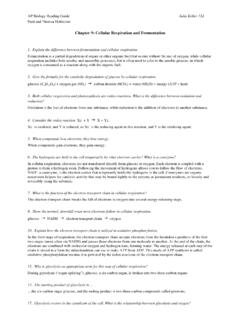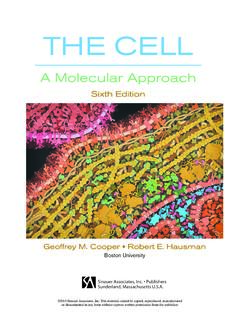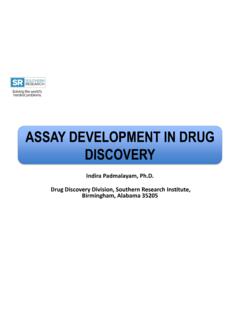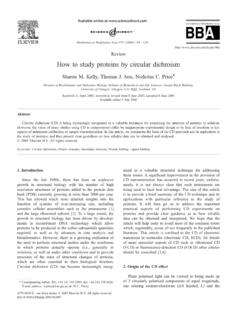Transcription of Chapter 18: Regulation of Gene Expression
1 AP Biology Reading Guide Julia Keller 12d Fred and Theresa Holtzclaw Chapter 18: Regulation of gene Expression 1. All genes are not on all the time. Using the metabolic needs of E. coli, explain why not. If the environment is lacking in the amino acid tryptophan, which the E. coli bacterium needs to survive, the cell responds by activating a metabolic pathway that makes tryptophan from another compound. Later, if the human host eats a tryptophan-rich meal, the bacterial cell stops producing tryptophan, thus saving itself from squandering its resources to produce a substance that is available from the surrounding solution in prefabricated form.
2 Thus, bacteria tune their metabolism to changing environments. 2. What are the two main ways of controlling metabolism in bacterial cells? Cells can adjust the activity of enzymes already present, a fairly fast response which relies on the sensitivity of many enzymes to chemical cues that increase or decrease their catalytic activity. The activity of the first enzyme in the tryptophan synthesis pathway is inhibited by the pathway's end product. This form of feedback inhibition, typical of anabolic pathways, allows a cell to adapt to short-term fluctuations in the supply of a substance it needs.
3 Cells can also adjust the production level of certain enzymes; that is, they can regulate the Expression of the genes that encode the enzymes. Many genes of the bacterial genome are switched on or off by changes in the metabolic status of the cell. 3. Feedback inhibition is a recurring mechanism throughout biological systems. E. coli regulating tryptophan synthesis is an example of negative inhibition because the operons are switched off by the active form of the repressor protein. 4. What is a promoter?
4 In the 1930s, Beadle speculated that in Drosophila, each of the various mutations affecting eye color blocks pigment synthesis at a specific step by preventing production of the enzyme that catalyzes that step. However, neither the chemical reactions nor the enzymes that catalyze them were known at the time. 5. What is the operator? A key advantage of grouping genes of related function into one transcription unit is that a single on-off switch can control the whose cluster of functionally related genes; in other words, these genes are coordinately controlled.
5 The switch is a segment of DNA called an operator. Positioned within the promoter, or in some cases, between the promoter and the enzyme-coding genes, the operator controls the excess of RNA polymerase to the genes. 6. What is an operon? All together, the operator, the promoter, and the genes they control the entire stretch of DNA required for enzyme production of the tryptophan pathway constitute an operon. 7. List the three components of an operon, and explain the role of each one. The operator controls the access of RNA polymerase to the genes.
6 The promoter is the DNA sequence where RNA. polymerase attaches and initiates transcription. The operator and the promoter coordinately control a cluster of functionally related genes. 8. How does a repressor protein work? The operon can be switched off by a repressor protein, which binds to the operator and blocks attachment of RNA. polymerase to the promoter, preventing transcription of the genes. A repressor protein is specific for the operator of a particular operon. The binding of repressors to operators is reversible.
7 An operator vacillates between two states: one without the repressor bound and one with the repressor bound. The relative duration of each state depends on the number of active repressor molecules around. The trp repressor, like most regulatory proteins, is an allosteric protein, with two alternative shapes, active and inactive. The trp repressor is synthesized in an inactive form with little affinity for the trp operator. Only if tryptophan binds to the trp repressor at an allosteric site does the repressor protein change to the active form that can attach to the operator, turning the operon off.
8 Tryptophan functions in this system as a corepressor, a small molecule that cooperates with a repressor protein to switch an operon off. 9. What are regulatory genes? A regulatory gene , located some distance from the operon and with its own promoter, is expressed continuously, although at a low rate. 10. Distinguish between inducible and repressible operons, and give an example of each. The trp operon is said to be a repressible operon because its transcription is usually on but can be inhibited when a specific small molecule (in this case, tryptophan) binds allosterically to a regulatory protein.
9 In contrast, an inducible operon is usually off but can be stimulated when a specific small molecule interacts with a regulatory protein. The lac operon includes two other genes coding for enzymes that function in lactose utilization. The entire transcription unit is under the command of one main operator and promoter. The regulatory gene , lacI, located outside the operon, codes for an allosteric repressor protein that can switch off the lac operon by binding to the operator. While the trp repressor is inactive by itself and requires tryptophan as a corepressor in order to bind to the operator, the lac repressor, in contrast, is active by itself, binding to the operator and switching the lac operon off.
10 In this case, a specific small molecule, called an inducer, inactivates the response. 12. Compare and contrast the lac operon to the trp operon. The enzymes of the lactose pathway are referred to as inducible enzymes because their synthesis is induced by a chemical signal. Analogously, the enzymes for tryptophan synthesis are said to be repressible. Repressible enzymes generally function in anabolic pathways, which synthesize essential end products from raw materials (precursors). By suspending production of an end product when it is already present in sufficient quantity, the cell can allocate its organic precursors and energy for other uses.















